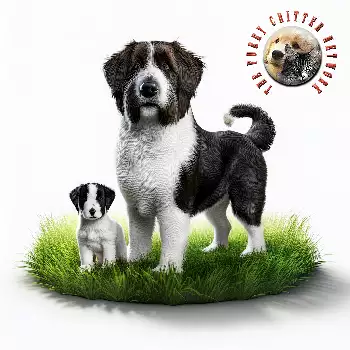The Stabyhoun traces its ancestry to the forested regions of eastern and southeastern Friesland in the Netherlands, where it developed as an all-purpose farm dog during the 1800s. References to the breed appear in Friesian literature from the early nineteenth century, including works by notable Friesian authors Joost Halbertsma, Waling Dijkstra, and Nynke fan Hichtum. These early writings describe a long-haired piebald dog valued as both a devoted family companion and capable hunting partner. The breed's ancestors likely include spaniels brought to the Low Countries during the Spanish occupation, and the Stabyhoun shares genetic heritage with other Dutch pointing breeds including the Drentsche Patrijshond and the Small Munsterlander.
Unlike many European hunting breeds developed for aristocratic sportsmen, the Stabyhoun evolved as the working dog of common farmers and small landholders in rural Friesland. These owners could afford to keep only one dog, necessitating an animal capable of performing multiple roles: hunting fox, small game, and upland birds during hunting season; controlling vermin including moles, rats, and polecats around the farmstead; serving as a watchdog to protect property; and providing companionship to family members. This utilitarian breeding focus created a remarkably versatile dog that could point and retrieve game, work in water, track prey, and switch seamlessly from hunting partner to gentle household pet.
For many years, Friesian farmers crossbred the Stabyhoun with another local breed, the Wetterhoun, to combine desirable traits from both lines. The Wetterhoun contributed a more robust physique and weather-resistant coat, while the Stabyhoun offered a softer temperament and superior retrieving ability. However, this practice threatened the distinct identity of both rare breeds. In the early twentieth century, dedicated breed enthusiasts recognized the need to preserve these unique Friesian dogs as separate breeds. Their efforts led to official recognition of the Stabyhoun by the Raad van Beheer, the Dutch Kennel Club, in 1942. The first written breed standard was drafted on February 10, 1944.
Following recognition, crossbreeding between Stabyhouns and Wetterhouns ceased entirely to protect the genetic integrity of each breed. In 1947, enthusiasts established the Nederlandse Vereniging voor Stabijhoun en Wetterhounen to represent the interests of both Friesian breeds and coordinate breeding programs. Until the 1960s, the Stabyhoun remained virtually unknown outside its native province, with the entire population concentrated in Friesland. The Federation Cynologique Internationale granted international recognition in 1960, classifying the breed in Group 7 as a pointing dog.
Expansion beyond the Netherlands occurred slowly and deliberately. The first Stabyhouns arrived in North America in the 1990s, with the first American litter born in 1994. The Ameri-Can Stabyhoun Association formed in 2006 to coordinate breeding efforts and work toward AKC recognition, achieving Foundation Stock Service status that same year. Small but dedicated populations have since developed in the United Kingdom, Scandinavia, and other European countries. Despite growing international interest, the breed remains exceptionally rare, with an estimated population of only six to seven thousand dogs worldwide. The Netherlands continues to house the largest population and maintains the most genetic diversity within the breed.
Today's Stabyhoun remains remarkably unchanged from its nineteenth-century ancestors in both appearance and function. Breed organizations worldwide enforce strict breeding regulations to preserve the Stabyhoun's health, temperament, and working ability while carefully managing the limited gene pool. Breeders must obtain approval from breed committees before mating, health screenings are mandatory, and restrictions limit the number of litters any individual dog can produce. This careful stewardship reflects the breed's status as a Dutch national treasure and ensures that the Stabyhoun continues to embody the versatile, devoted character that made it indispensable to Friesian farmers generations ago.

